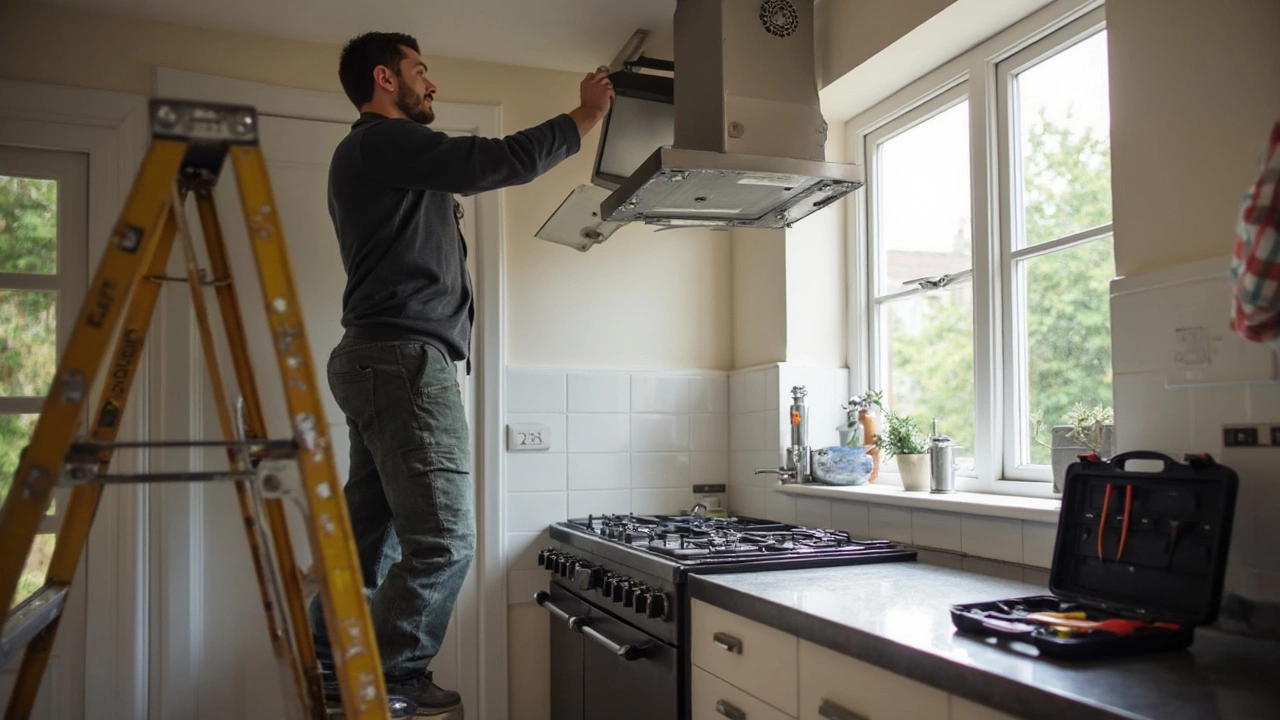Most people think replacing an extractor fan is a massive headache—something only an electrician should touch. Sounds about right? Not always. Sure, if your kitchen fan is caked in ten years of grease and the wiring looks like spaghetti, you’ll need some patience. But in a lot of cases, swapping out a tired old fan for a new one is more straightforward than you’d expect.
If your fan suddenly died or it just screams whenever you switch it on, you don’t have to panic. The basic replacement process mostly involves unscrewing the old unit, disconnecting a couple of wires, and slotting a new one into the same spot. You’ll likely need just a screwdriver, maybe some pliers, and a little common sense. But here’s the kicker—not all fans are built the same, and some give you grief when it comes to the wiring or hole size.
It’s not just about unplugging and replugging. Things like fused spurs, awkward wall access, and hidden wiring can slow you down. Plus, there’s always the mess—expect dust, a few stubborn screws, and maybe a surprise wasp nest if you’re dealing with an outside vent. Still, with a bit of planning, most homeowners can tackle a fan replacement in under an hour.
- What Makes Extractor Fan Replacement Tricky?
- Can You DIY or Should You Call an Expert?
- Step-by-Step Replacement Tips
- Common Pitfalls and How to Dodge Them
What Makes Extractor Fan Replacement Tricky?
You’d think swapping out an extractor fan would be just as easy as plugging in a new toaster, right? Not so fast. The biggest thing that makes extractor fan replacement frustrating is that no two setups are exactly alike. Bathroom fans, kitchen fans, inline or wall-mounted—manufacturers love to change sizes, mounting styles, and even the wiring layout. So that shiny fan you bought might not be a drop-in swap after all.
Wiring catches a lot of people off guard. Older homes can have unpredictable electrical setups—sometimes you’ll find colors or connections that don’t match the new fan's instructions. And if your old unit is wired directly into a circuit (instead of a plug or terminal block), you might need a voltage tester or even to isolate the circuit before starting. Sometimes, fans are connected to both the light and a pull cord, adding another layer of confusion to what wire goes where.
Size is another headache. Most extractor fans are built to standard diameters—usually 100mm, 125mm, or 150mm—but even a few millimeters off means you’ll be chiseling drywall or trying to patch up awkward gaps. Kitchen extractor fans often have thicker ducting or need a stronger motor compared to what you find in a bathroom. Plus, older fans can be stuck with years' worth of grime, rusted screws, or brittle plastic that cracks when you try to remove them.
There’s also the mess nobody warns you about. Taking the fan out can shower you in dust, old insulation, or spider webs. If your fan vents straight outside, you might even get a cold blast or critters dropping in.
Here’s a quick comparison of what tends to trip people up, depending on where the fan is located:
| Location | Main Issues |
|---|---|
| Bathroom Ceiling | Condensation, tight attic space, short wires |
| Kitchen Wall | Grease buildup, heavy motors, thick ducting |
| Inside Loft | Limited working space, navigating joists |
| External Wall | Rainwater leaks, broken vents, outside pests |
The bottom line? It’s not always a quick unplug and replug job. Preparation makes a huge difference, especially if you have to deal with old wiring, weird mounting holes, or surprise critters. Know what you’re facing before you start, and you’ll save yourself a lot of hassle.
Can You DIY or Should You Call an Expert?
If the idea of replacing an extractor fan has you wondering if it’s a job for a pro, you’re not alone. Here’s the truth: plenty of homeowners swap out their own fans, especially if they can use a screwdriver safely and know how to flip their fuse box switches. The tricky part comes down to what’s hiding in your walls and whether your wiring plays nice.
The biggest question is always safety. If your fan hooks up to standard wiring and you feel confident turning off power at the breaker, you’re probably fine to DIY. But if you spot extra wires, odd colors, or get spooked by electrical stuff, pause for a second. UK homes, for example, sometimes have fans connected to lighting circuits or with built-in timers, which can get confusing fast. Messing up means not just a dead fan, but maybe a blown fuse or even a small fire risk. That’s where experts come in.
Here’s when you should definitely call in an electrician:
- You’re not 100% sure which breaker kills the power to the fan.
- The wiring looks damaged, burned, or there are more than three wires going into the unit.
- Your fan is in a bathroom and your local regulations say only a qualified person can touch that area (happens a lot for bathroom electrics).
- There’s visible mold, water leaks, or signs something weird is going on behind the wall.
But say you already checked the power was off, and your replacement is just a swap—with no “surprise, this wall eats up drill bits!” moments—most fans come with clear instructions right in the box.
Check out this quick comparison table, showing the expected time, typical skill level, and cost for both DIY and expert help:
| Option | Skill Needed | Time | Approx. Cost (UK 2025) |
|---|---|---|---|
| DIY Extractor Fan Replacement | Basic electrical skills | 45 mins – 1.5 hrs | £30-£60 (fan only) |
| Professional Electrician | Qualified, certified | 30 mins – 1 hr | £120-£200 (labour + fan) |
If you just want the headache gone, calling an electrician speeds things up, but you’ll pay extra. Doing it yourself can save you more than half the total cost, as long as you respect safety rules. So, what’s worth more for you: a Saturday morning or some money in your wallet?
The big thing is knowing your limits. If you’re unsure, there’s no shame getting a pro. When it clicks, though, there’s real satisfaction swapping out that noisy, dusty old fan for something fresh and silent.

Step-by-Step Replacement Tips
Ready to dive into replacing your extractor fan? Here’s a straightforward guide to get it done without the headaches. Trust me, the trick is to work slow and pay attention to what you’re disconnecting. This process covers the basics for most extractor fan replacement situations, whether you’re fixing a bathroom or kitchen fan.
- Cut the power. Safety first—switch off the power to the fan at your fuse box. Double check with a voltage tester, especially if you’re replacing a bathroom fan. No one wants a surprise zap.
- Remove the old fan cover. Most covers pop off with a little prying. If it’s greasy (kitchen fans always are), grip with a towel.
- Unscrew and free the fan body. Look for screws in the corners. Some models need you to remove a couple of hidden screws inside. Once unscrewed, gently pull the fan unit out from the wall or ceiling.
- Disconnect the wiring. Take a photo of the wiring before you start! It’ll save you big time later. You’ll usually see two or three wires—live, neutral, and possibly earth. Loosen the terminal screws and disconnect.
- Clean any mess. Scrape out dust, cobwebs, or old sealant around the vent. If you’re replacing a really old fan, check for crumbled plaster or signs of moisture build-up.
- Install the new fan. Use your wiring photo to match wires to the correct terminals: brown (live), blue (neutral), and if there’s a green/yellow one, that’s earth. Double check your new fan’s wiring setup in the manual.
- Screw the new unit in place. Make sure it's lined up with the vent opening. Screw everything in tight, but don’t overdo it—you don’t want to crack the housing.
- Pop on the cover and test. Flip the power back on and let it run for a minute. Listen for weird noises or vibrations. Make sure it pulls air—you can hold a bit of toilet paper by the grill to check suction.
Most extractor fans on the market today are built to match standard hole sizes, so you won’t often need to widen anything. But if you’re upgrading to a more powerful fan, measure before you buy. Some bigger models need a larger hole or different mounting plate.
| Job Phase | Typical Time Needed | Tools Needed |
|---|---|---|
| Cut power & prep | 5 minutes | Voltage tester, screwdriver |
| Remove old fan | 10–15 minutes | Screwdriver, towel |
| Wire & fit new unit | 15–20 minutes | Screwdriver, pliers |
| Cleanup & test | 5–10 minutes | Vacuum (optional) |
Give yourself more time if you’re doing this for the first time or dealing with stubborn screws. If anything looks dodgy or you find damaged wiring, call a pro. But for a straight swap, most folks knock this out in under an hour.
Common Pitfalls and How to Dodge Them
Swapping out an extractor fan can trip you up if you don’t know the snags ahead of time. Here’s what throws most folks off and what you can do so your replacement doesn’t turn into a headache.
- Wrong Fan Size: It’s way too easy to buy a fan that doesn’t fit the hole in your wall or ceiling. Before you order, grab a tape measure and make sure the diameter and depth match your old unit. Lots of extractor fan units come in similar, but not equal, sizes. A mismatch means you’ll be patching drywall, which nobody enjoys.
- Messing Up the Wiring: If you get the wires crossed, the fan won’t work—or worse, you could trip a breaker or fry the fan. Double-check you’ve killed the power at the breaker before you do anything. Take a quick photo before unplugging anything so you have a reference later. If colors or numbers on wires confuse you, that’s a sign you might want to phone a pro.
- Not Checking Ducting and Grilles: Sometimes, it’s not just the fan—the duct or vent cover on the outside is clogged with dust or has a bird’s nest stuck in it. If you just slap in a new fan without clearing the passage, airflow won’t improve and you’ll still get annoying smells or steam build-up.
- Damp and Mold Problems: If your old fan wasn’t doing its job for a while, there’s a decent chance you’ve got hidden mold around the duct. This needs scrubbing or even replacing bits of drywall, otherwise the fresh fan just keeps blowing musty air.
- Ignoring Noise Ratings: Some fans are so loud you’ll regret every shower. Check the decibel (dB) rating—anything under 30 dB is considered quiet. It’s worth paying a few extra bucks for a silent unit, or you’ll be getting complaints from the rest of the house.
Want a quick snapshot of problems and what they lead to? Here’s a handy cheat sheet:
| Pitfall | Likely Result | Quick Fix |
|---|---|---|
| Wrong unit size | Won't fit, more wall work | Measure twice, buy once |
| Poor wiring | Fails to work, trip breaker | Take photos, double-check connections |
| Blocked duct | Weak airflow, odors remain | Clean ducts before installing new fan |
| Mold build-up | Bad smells, health problems | Deal with mold before mounting fan |
| Noisy fan | Loud, annoying | Pick one with lower dB rating |
One last thing: always use the right screws and anchors when mounting your extractor fan replacement. If you use the wrong size, it might vibrate and rattle every time you switch it on. Spending an extra five minutes to get things right on the first go beats having to redo the whole job.





